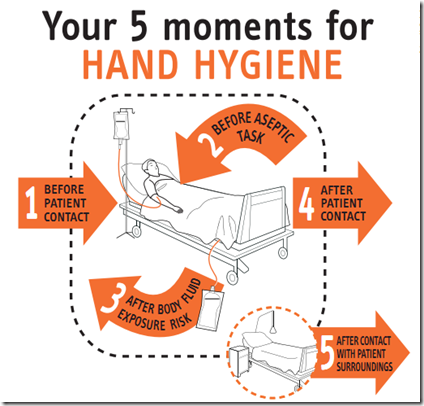Credit WHO
# 8816
One hundred and sixty-six years ago, a Hungarian physician named Ignaz Semmelweis published a controversial medical book called Etiology, Concept and Prophylaxis of Childbed Fever. Semmelweis demonstrated that infections could be greatly reduced by simply having doctors wash their hands before performing gynecological exams.
While that makes sense today, at the time his theories were considered radical (Pasteur wouldn’t come up with his `germ theory’ for another 17 years). Besides, it was outrageous to suggest that doctors might actually be causing disease and death among their patients.
Semmelweis was ridiculed, ostracized and eventually forced to leave his hospital post. He died at the age of 47 in an asylum, a broken man. Remarkably,16 decades later, infection control professionals must still continually remind HCWs (Health Care Workers) of the importance of good hand hygiene.
This assessment from the CDC on the burden of Hospital Acquired Infections in the United States is from 2011.
Which is the reason that the CDC, the ECDC, and the World Health Organization (among others) have promoted enhanced hand hygiene as the first – and most basic – step in reducing HAIs. A few of their campaigns I’ve covered in the past include:
Aye, There’s The Rub
Fomite to Fingers To Face: A Triple Play Combination
A Movement With Five Moments
Global Clean Your Hands Day
And based on a variety of metrics, including onsite auditors – whose job it is to observe and track compliance of HCWs – many hospitals are reporting much better hand hygiene stats.
But we’ve a new study, published in the BMJ, that suggests some of this new-found compliance may be due to observational bias – the so called `Hawthorne Effect’ – where the compliance of `watched’ HCWs may be significantly higher than those not under observation.
First a link to the open access study, which is long, detailed, and worth very much reading in its entirety.
BMJ Qual Saf doi:10.1136/bmjqs-2014-003080
- Original research
Quantification of the Hawthorne effect in hand hygiene compliance monitoring using an electronic monitoring system: a retrospective cohort study

Jocelyn A Srigley1,2, Colin D Furness3,4, G Ross Baker1, Michael Gardam5,6
Published Online First 7 July 2014
Abstract
Background The Hawthorne effect, or behaviour change due to awareness of being observed, is assumed to inflate hand hygiene compliance rates as measured by direct observation but there are limited data to support this.
Objective To determine whether the presence of hand hygiene auditors was associated with an increase in hand hygiene events as measured by a real-time location system (RTLS).
Methods The RTLS recorded all uses of alcohol-based hand rub and soap for 8 months in two units in an academic acute care hospital. The RTLS also tracked the movement of hospital hand hygiene auditors. Rates of hand hygiene events per dispenser per hour as measured by the RTLS were compared for dispensers within sight of auditors and those not exposed to auditors.
Results The hand hygiene event rate in dispensers visible to auditors (3.75/dispenser/h) was significantly higher than in dispensers not visible to the auditors at the same time (1.48; p=0.001) and in the same dispensers during the week prior (1.07; p<0.001). The rate increased significantly when auditors were present compared with 1–5 min prior to the auditors’ arrival (1.50; p=0.009). There were no significant changes inside patient rooms.
Conclusions Hand hygiene event rates were approximately threefold higher in hallways within eyesight of an auditor compared with when no auditor was visible and the increase occurred after the auditors’ arrival. This is consistent with the existence of a Hawthorne effect localised to areas where the auditor is visible and calls into question the accuracy of publicly reported hospital hand hygiene compliance rates.
You’ll find a summary of this research the following press release from the University Health Network
Health-care worker hand hygiene rates increase three-fold when auditors visible
Hand hygiene rates were found to be three times higher when auditors were visible to healthcare workers than when there were no auditors present, according to a study in a major Canadian acute care hospital.
<SNIP>
The study examined the Hawthorne effect, also known as observation bias – the tendency of people to change their behavior when they are aware of an observer – using an electronic monitoring hand hygiene system in real-time, eliminating many of the biases inherent to human observation. Ultrasound "tags" on soap dispensers transmitted a signal to a nearby receiver each time the levers were pushed, and a time-stamped hand hygiene wash was recorded in a central data base.
<SNIP>
"The difference in hand hygiene rates, when an auditor is present compared to those times when one is not, is huge in this study, and we showed this effect to be very consistent," says Dr. Gardam, who is also an Associate Professor of Medicine at the University of Toronto.
"The magnitude of what we found calls into question the accuracy of directly observed hand hygiene rates and the usefulness of measuring and reporting them," says Dr. Gardam. "That said, human auditing of hand hygiene has been helpful to draw attention to this important preventative measure—we just can't stop focusing on it because our posted rates are not nearly as high as we think they are."
While it stands to reason that `watched’ HCWs are probably more inclined to hit the hallway mounted alcohol dispenser as they walk by, the surprise here is the three-fold difference in compliance levels when auditors are present. This study is subject to a number of limitations (which are described in the BMJ article).
For more on the ongoing battle against HAIs, you may with to revisit:
Assessment Of Hand Hygiene Strategies In US Healthcare Facilities
SHEA Infection Control Recommendations On HCW Attire
Study: Exam Gloves, Dispensers & Bacterial Contamination

